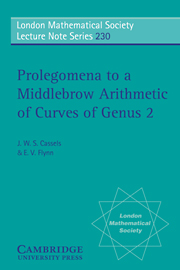Book contents
- Frontmatter
- Contents
- Foreword
- Background and conventions
- Chapter 1 Curves of genus 2
- Chapter 2 Construction of the jacobian
- Chapter 3 The Kummer surface
- Chapter 4 The dual of the Kummer
- Chapter 5 Weddle's surface
- Chapter 6 ℭ/2ℭ
- Chapter 7 The jacobian over local fields. Formal groups
- Chapter 8 Torsion
- Chapter 9 The isogeny. Theory
- Chapter 10 The isogeny. Applications
- Chapter 11 Computing the Mordell-Weil group
- Chapter 12 Heights
- Chapter 13 Rational points. Chabauty's Theorem
- Chapter 14 Reducible jacobians
- Chapter 15 The endomorphism ring
- Chapter 16 The desingularized Kummer
- Chapter 17 A neoclassical approach
- Chapter 18 Zukunftsmusik
- Appendix I MAPLE programs
- Appendix II Files available by anonymous ftp
- Bibliography
- Index rerum et personarum
Foreword
Published online by Cambridge University Press: 10 November 2010
- Frontmatter
- Contents
- Foreword
- Background and conventions
- Chapter 1 Curves of genus 2
- Chapter 2 Construction of the jacobian
- Chapter 3 The Kummer surface
- Chapter 4 The dual of the Kummer
- Chapter 5 Weddle's surface
- Chapter 6 ℭ/2ℭ
- Chapter 7 The jacobian over local fields. Formal groups
- Chapter 8 Torsion
- Chapter 9 The isogeny. Theory
- Chapter 10 The isogeny. Applications
- Chapter 11 Computing the Mordell-Weil group
- Chapter 12 Heights
- Chapter 13 Rational points. Chabauty's Theorem
- Chapter 14 Reducible jacobians
- Chapter 15 The endomorphism ring
- Chapter 16 The desingularized Kummer
- Chapter 17 A neoclassical approach
- Chapter 18 Zukunftsmusik
- Appendix I MAPLE programs
- Appendix II Files available by anonymous ftp
- Bibliography
- Index rerum et personarum
Summary
The arithmetic (= number theory) of curves of genus 0 is well understood. For genus 1, there is a rich body of theory and conjecture, and in recent years notable success has been achieved in transforming the latter into the former. For curves of higher genus there is a rich body of theory with some spectacular successes (e.g. Faltings' proof of ‘Mordell's Conjecture’), but our command is still rudimentary. For genus 1, a concrete question about an individual curve can usually be answered by one means or another: for higher genus, this is far from the case.
For curves of genus 0 and 1 the road between general theory and particular cases is no one-way street. Numerous individual cases were investigated by amateurs as well as as by distinguished mathematicians such as Diophantos, Fermat, Euler, Sylvester, Mordell, Selmer, Birch and Swinnerton-Dyer. Regularities which emerged, sometimes quite unexpectedly, suggested theorems, which could sometimes be proved. The new theorems suggested new questions. For higher genus, existing theory is notoriously unadapted to the study of individual curves, and few have been elucidated. What is needed is a corpus of explicit concrete cases and a middlebrow arithmetic theory which would provide both a practicable means to obtain them and a framework to understand any unexpected regularities.
Such a theory will, of course, draw freely from the existing body of knowledge, but the emphasis on feasibility gives new perspectives.
- Type
- Chapter
- Information
- Publisher: Cambridge University PressPrint publication year: 1996

